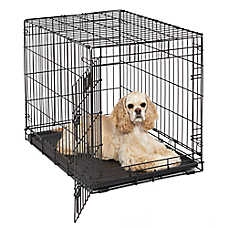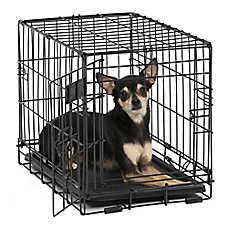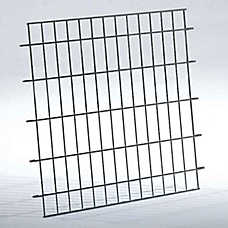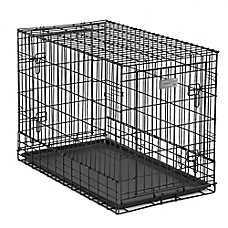Benefits & Tips of Using Dog Crates & Dog Gates for Training
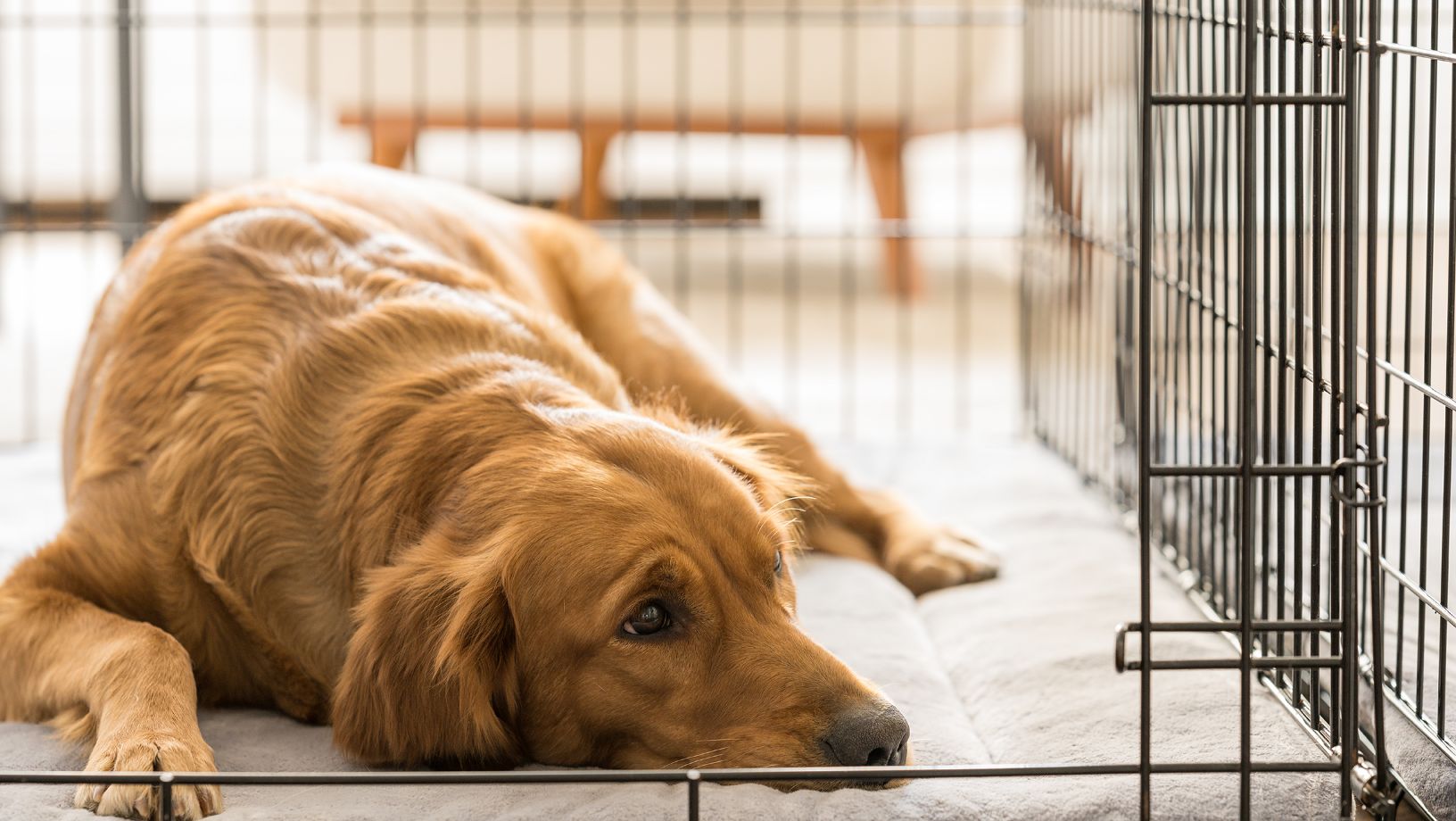
In this Article
Many pet parents use dog crates and dog gates to train their pups, set boundaries, or contain them for their comfort/safety. Some pups love to sleep and relax in their crates, other pups might need a gate to protect them from dangers like stairs. There are a ton of reasons why a family might be looking into the use of dog crates and gates for training.
What Are Dog Crates?
Dog crates, sometimes called cages or kennels, are a safe and contained area that a dog can reside in for short bursts of time. These containers are big enough to hold a dog but small enough that a dog isn’t roaming around. Crates have many uses, the most common being:
1. Security. Many dogs see their crate as a source of security and comfort that they can seek respite in throughout the day.
2. Training. Crates can be a great aid in teaching a pup how to stay home alone.
3. Traveling. Dog crates can be used for travel purposes to keep a pup safe on long car rides or contained for flying.
What Are Dog Gates and Pens?
Dog gates and playpens are different from crates in the sense that they do not contain a dog in just a small space. Dog gates are used to contain a dog to a room or small area, while still giving them space to walk around. There are many different uses for dog crates that mostly relate to their safety. They are often used to block dogs from entering unsafe areas like house renovations, steep stairways, swimming pools, etc without their parent's permission.
Different Types of Dog Gates/Pens:
1. Pressure Mounted Gates. These are great for pet parents looking for something simple that does not require tools or hardware, want a gate that is easy to move, block off angled openings, or have a dog that tends to squeeze through tight spaces.
2. Hardware Mounted Gates. These are great for pet parents whose pup tends to knock things over, do not plan on moving the gate, or need a gate at the top of a staircase.
3. Free-Standing Gates. These are great for pet parents with small dogs, dogs who do not jump over things or knock things over, need an easily portable gate, or need a gate that spans a wide distance. These gates are not safe for stare cases.
4. Exercise Pens. These are great for pet parents who need a temporary/portable area to contain their pet, add a contained lounging space to a sleeping spot, want to include their dog in outdoor activities without them running off, need to contain multiple dogs, or need to give your dog a safe place to dry off after a bath.
Do Puppies Need Special Puppy Crates or Puppy Gates?
If you are bringing home a new puppy and are wondering whether or not puppies need a special kind of puppy crate or puppy grate, the short answer is yes. Puppies need specific types of containment that support their size and development.
For example, if your puppy is potty training, then their crate should not be too big. They only need enough room to lie down comfortably, be able to stand up, adjust themselves, and so on. If a puppy crate is too big, then the puppy is at an increased risk of having accidents in their space. This is because puppies are less likely to use the restroom in their own space and if there is enough room, they can relieve themselves at one end and go back to sleep on the other end.
When it comes to puppy gates and playpens, pet parents need to make sure the puppy gate and pen are the right sizes to keep the puppy contained. Depending on the size of your puppy, you might need to pay attention to the spacing between bars on the gate so that they do not have enough room to squeeze through and get loose. Ultimately, your pup needs a puppy crate for puppy gate that compliments their size and development and should be upgraded to adapt as they grow.
Benefits of Using Dog Crates and Dog Gates for Training:
There are many benefits when it comes to using dog grates and dog gates for training. According to the UC Davis College of Veterinary Medicine, some of those benefits include:
1. Limit Accidents
While your puppy is growing and developing, there will be a time where they are still strengthening their control along with their understanding of when and where they can use the bathroom. The right puppy crate can have an impact on the number of accidents your puppy has. Puppy gates can limit accidents to one location in your home if they should happen.
2. Reduce Chewing
Another trait of puppies that can be cute in the right context is their love to chew. Puppies and dogs love to chew and while adult dogs might know not to chew on your belongings, puppies are not always that wise. Crate training can be a great way to reduce chewing on items in your home that are not approved for that purpose.
3. Train Dog to Be Home Alone
When a dog is learning how to be home alone, limiting their space can be a great way to keep them safe and feeling secure while you’re gone. Dog crate mats and crate covers are great additions for their comfort.
4. Peace of Mind
Leaving your puppy at home is tough, especially when they’re your best friend who you wish you could take everywhere with you! Taking the time to crate train can give you peace of mind that your puppy is safe and out of trouble while you’re out and about.
Tips for Crate Training Your Dog:
Start Slowly
Start crate training slowly. You want your dog to enjoy the crate, so put some treats or toys in there. (It’s also a great idea to have a super-special toy that’s only for use inside the crate.) Encourage your dog to go in after them, but don’t force the issue.
Keep this up for a few days or until your pet cheerfully enters the crate without coaxing.
Once that happens, try closing the crate door for a few seconds and stay close by. Work your way up to five minutes — again, don’t push it - Some dogs take to their crates right away; others need a few days. If your dog seems anxious when you shut the crate door, be right there to let them out. Then try again later.
Get Them Settled In
As your dog gets more comfortable spending time in the closed crate, try leaving the room for a few minutes. When you let them out, play it cool; don’t go overboard with attention. Otherwise, your dog may learn to get anxious inside the crate, waiting to get out and get that love and praise.
Once your dog crates calmly in a room - alone for 30 minutes, you can try an overnight stay. Puppies should be crated in your bedroom for housetraining purposes. When they’re grown, they can be a few rooms away, but not too far or they’ll feel a little left out.
Crate your dog for a brief period every day, too. This way, if there’s ever a time you actually need to crate your pup, it won’t be a big deal.
Need other puppy supplies? PetSmart also carries training treats, potty training supplies, and more.
PetSmart also offers convenient shopping with curbside or in-store pickup. Need something today? We have select items available for same-day delivery in most areas powered by DoorDash. For items you purchase frequently, PetSmart has Autoship that automatically delivers the items you want to your door as often as you’d like. Check the website to see which items are eligible.
Information in this article is not intended to diagnose, treat or cure your pet and is not a substitute for veterinary care provided by a licensed veterinarian. For any medical or health-related advice concerning the care and treatment of your pet, contact your veterinarian.
